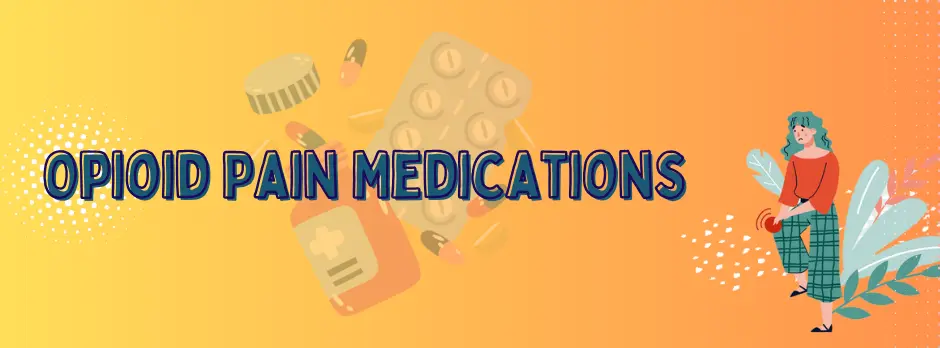
Some of the common side effects of opioids are drowsiness, dizziness, constipation, respiratory depression, and nausea or vomiting.
If you suffer from long-standing pain, then the search for lasting relief is challenging. Chronic pain can interfere with your everyday activities, so enjoy life on your terms.
Pain medicines like opioids are a ray of hope for those seeking relief and improved quality of life.
Are opioid pain medications a good choice for your treatment? Let’s find out.
Introduction To Opioid Pain Medication
Opioids, also called narcotics, are a large class of prescription medications used to treat severe or persistent pain. They are found in the opium poppy plant. Some opioids are made directly from the plant, and others are made in labs by scientists using the same chemical structure [1].
How Do Opioids Work?
Opioids attach to proteins known as opioid receptors on the nerve cells in the spinal cord, gut, brain, and other parts of the body. As a result, the opioids block pain messages sent from the body via the spinal cord to the brain. This results in relief from pain sensation.
Uses Of Opioids
Opioids are approved for managing severe to moderate pain. This can include –
- Cancer-related pain
- Post-surgical pain
- Vascular pain
- Some types of acute pain (sudden, severe pain that lasts for a short period) [2].
Types Of Opioids
The list of opioid pain medications is discussed below –
-
Hydrocodone
Hydrocodone is an FDA-approved opioid medication. It is sold under numerous brand names such as Norco, Vicodin, Zohydro ER, Lortab, and others.
-
Oxycodone
Oxycodone is another opioid medication that is available in different dosage forms, including as an oral solution and tablets. It is an excellent option for moderate to severe pain. It is available under the brand names Percocet, Percodan, Roxicodone, and others.
-
Tapentadol
Tapentadol is one of the most powerful opioid analgesics approved by the FDA for treating chronic and severe pain. It is marketed under various brand names such as Palexia, Nucynta, Etadil, and Aspadol.
Out of all these brands, Aspadol manufactured by the leading pharmaceutical company Signature Pharmaceuticals is the most desirable.
Aspadol has a quick onset of action which is 30 minutes after administration. It has a lower risk of opioid-related side effects making it a more safer choice of analgesic.
If you’re interested in learning more about Aspadol, then explore our Aspadol 100 mg product page today.
-
Fentanyl
Fentanyl is designed for cancer patients who have pain that is not controlled by other medications. It is available as tablets, nasal sprays, lozenges, and a patch. Some of its popular brands include Abstral, Fentora, and Subsys.
-
Methadone
Methadone is used to manage pain as well as for detoxification from illicit opioids, such as heroin. It is available as an oral tablet, liquid, or a small disc that can be added to water or other liquids.
Opioids Administration
Opioids are taken in tablet form, but they can also be taken as lollipops or lozenges. Some are taken through a vein, by injection and others are administered through a patch placed on the skin.
Opioids Drug Interaction
It’s crucial to inform your healthcare provider which medicines, supplements, or other substances you’re taking before starting opioids.
Drugs and substances that may interact with opioid pain medications are as follows –
It’s crucial to inform your healthcare provider which medicines, supplements, or other substances you’re taking before starting opioids.
Drugs and substances that may interact with opioid pain medications are as follows –
- Alcohol
- Certain antidepressants
- Antibiotics such as clarithromycin
- Anti-seizure medicines such as carbamazepine
- Alcohol
- Certain antiretroviral drugs are used for HIV including indinavir, ritonavir, and atazanavir.
- Marijuana/cannabis
- Medication used to treat nerve pain, such as gabapentin, and pregabalin
- Medications for sleeping disorders, such as zolpidem.
Side Effects Of Opioids
Common side effects include –
- Drowsiness
- Nausea or vomiting
- Constipation
- Dizziness
- Respiratory depression – shallow and slow breathing rate.
Uncommon symptoms of opioids include –
- Muscle rigidity
- Hormonal and immune system dysfunction
- Itchy skin
- Dry mouth
- Quick, involuntary muscle jerks
- Delayed gastric emptying (the process by which stomach contents move into the small intestine).
- Arrhythmia (improper breathing of the heart).
Long-Term Effects Of Opioids
Some of the long-term effects of opioid use are as follows [3]-
- Tolerance – As an individual takes repeated doses of opioids, the body starts requiring increased medication to experience the same effect of pain relief.
- Physical dependence – It’s also possible to become physically dependent on opioid medicines which means if you stop taking them you may experience withdrawal symptoms (such as anxiety, body aches, shaking, fever, hallucination, high blood pressure, rapid breathing, and other) and start craving the drug.
- Opioid Use Disorder – Opioid use disorder is a complex illness that causes compulsive use of opioid drugs even when an individual wants to stop.
Conclusion
Opioid pain medications are very potent drugs that affect your peripheral and central nervous system. Since it has the potential to cause addiction, it’s essential to make sure you follow your healthcare provider’s instructions for taking the medication. Do not take the drug more than your daily recommended dose.
FAQs
How long do opioids stay in your system?
Is tramadol an opioid?
What are opioids examples?
What is the onset of action of Aspadol 100 mg?
References
- Prescription Opioids DrugFacts, NIDA
- Opioids, clevelandclinic
- Opioids, hopkinsmedicine










